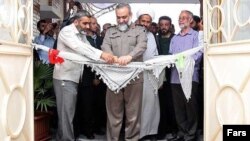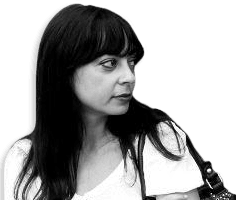Iranian authorities can be creative in their attempts to counter Western symbols.
But in an unprecedented move, the commander of Iran's Basij force, Mohammad Reza Naghdi, opened an exhibition of Basij cultural and artistic products on July 15 by cutting keffiyehs tied end-to-end -- apparently to avoid a usual ribbon-cutting ceremony, which might be too Western in his eyes. The traditional Arab headdress is used by members of Iran's Basij militia, who usually wear it on their shoulders. Iranian Supreme Leader Ayatollah Ali Khamenei also wears the keffiyeh on his shoulders at some of his public appearances, and other times gives them as gifts to followers.
Many Iranian soldiers in the 1980-88 Iran-Iraq conflict wore the keffiyeh, which as a result became one of the symbols of that war, described in Iran as "the sacred defense." In recent years, colorful keffiyehs have also become a popular fashion item among Iranian young people.
Speaking at the exhibition, Naghdi who was wearing his keffiyeh around his shoulder, said the art work by the Basij could win prestigious awards at international events.
Paintings, cartoons, and sculptures were among the works on display at the Basij exhibition.
The pro-government militia force has reportedly been heavily involved in the crackdown against Iran's opposition members.
Naghdi has been blacklisted by the United States for allegedly being responsible for or complicit in human rights abuses in the Islamic republic.
-- Houshang Jeirani
But in an unprecedented move, the commander of Iran's Basij force, Mohammad Reza Naghdi, opened an exhibition of Basij cultural and artistic products on July 15 by cutting keffiyehs tied end-to-end -- apparently to avoid a usual ribbon-cutting ceremony, which might be too Western in his eyes. The traditional Arab headdress is used by members of Iran's Basij militia, who usually wear it on their shoulders. Iranian Supreme Leader Ayatollah Ali Khamenei also wears the keffiyeh on his shoulders at some of his public appearances, and other times gives them as gifts to followers.
Many Iranian soldiers in the 1980-88 Iran-Iraq conflict wore the keffiyeh, which as a result became one of the symbols of that war, described in Iran as "the sacred defense." In recent years, colorful keffiyehs have also become a popular fashion item among Iranian young people.
Speaking at the exhibition, Naghdi who was wearing his keffiyeh around his shoulder, said the art work by the Basij could win prestigious awards at international events.
Paintings, cartoons, and sculptures were among the works on display at the Basij exhibition.
The pro-government militia force has reportedly been heavily involved in the crackdown against Iran's opposition members.
Naghdi has been blacklisted by the United States for allegedly being responsible for or complicit in human rights abuses in the Islamic republic.
-- Houshang Jeirani





